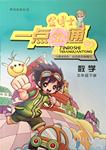
Where do most writers get their ideas? For Yoshiko Uchida, it all began with Brownie, a
five-month-old puppy. So excited was Yoshiko by Brownie’s arrival that she started keeping a
journal, writing about all the wonderful things Brownie did and the progress he made.
Soon she was writing about other memorable events in her life, too, like the day her family got their
first refrigerator. She also began writing stories, thanks to one of her teachers. Yoshiko wrote stories
about animal characters such as Jimmy Chipmunk and Willie the Squirrel. She kept on writing, sharing
the kitchen table with her mother, who wrote poems on scraps of paper and the backs of envelopes.
Yoshiko grew up in the 1930s in Berkeley, California. Her parents, both of whom had been born in
Japan, provided a loving and happy home for Yoshiko and her sister. They also provided a stream of
visitors to their home who later found their way into Yoshiko’s stories. One visitor who later appeared
in several of Yoshiko’s stories was the bad-tempered Mr. Toga, who lived above the church that her
family attended. Mr. Toga would scold anyone who displeased him. The children all feared him and
loved to tell stories about how mean he was and how his false teeth rattled (咯咯响) when he talked.
Yoshiko also included in her stories some of the places she visited and the experiences she had.
One of her favorite places was a farm her parents took her to one summer. The owners of the farm,
showed Yoshiko and her sister how to pump water from the well and how to gather eggs in the
henhouse. They fed the mules that later pulled a wagon loaded with hay while Yoshiko and the others
rode in the back, staring up at the stars shining in the night sky. Yoshiko, who lived in the city, had
never seen such a sight. As Yoshiko gazed up at the stars, she was filled with hope and excitement
about her life. The images of that hayride stayed with her long after the summer visit ended, and she
used them in several of her stories.
The experiences Yoshiko had and the parade of people who marched through her young life
became a part of the world she created in over twenty books for young people, such as
The Best Bad Thing and A Jar of Dreams. Because of such books, we can all share just a little bit
of the world and the times in which this great writer grew up.
1. The author tells about Mr. Toga’s false teeth in Paragraph 3 in order to ____________.
A. show health care was not good enough in Berkeley during the 1930s
B. provide an interesting detail in Yoshiko’s life and stories
C. show Yoshiko’s young life was difficult and frightening
D. tell about a beloved relative who helped Yoshiko learn how to write
2. In Paragraph 4 “the stars” probably refer to ____________.
A. family relationships
B. terrors in the night
C. limitless possibilities
D. sacrifices to benefit others
3. What does the underlined part in the last paragraph mean?
A. Yoshiko loved to write about parades.
B. Yoshiko met many interesting people.
C. Yoshiko liked to go for long walks with others.
D. Yoshiko preferred to talk to her pets instead of to people.
4. What is the main idea of this story?
A. People who live in the city should spend as much time as they can in the country.
B. Writers like Yoshiko Uchida must communicate with as many writers as possible.
C. Those who move to the United States often miss their homelands for many years.
D. Writers like Yoshiko Uchida look to the richness of their lives for writing sources.
 小学课堂作业系列答案
小学课堂作业系列答案 金博士一点全通系列答案
金博士一点全通系列答案科目:高中英语 来源:同步题 题型:阅读理解
查看答案和解析>>
湖北省互联网违法和不良信息举报平台 | 网上有害信息举报专区 | 电信诈骗举报专区 | 涉历史虚无主义有害信息举报专区 | 涉企侵权举报专区
违法和不良信息举报电话:027-86699610 举报邮箱:58377363@163.com